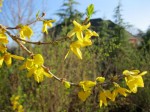 Spring would not be spring without the bright sprays of forsythias. The bushes give beauty to even the lowliest when they bloom so if you have a forsythia bush count your blessings and enjoy the show. But, you say, your bush does not bloom in spite of your attention and care. Let’s say that you have thinned it, cut it back, fertilized it, and ignored it, all to no avail. It simply won’t bloom. Consider these possible causes and the solutions.
Spring would not be spring without the bright sprays of forsythias. The bushes give beauty to even the lowliest when they bloom so if you have a forsythia bush count your blessings and enjoy the show. But, you say, your bush does not bloom in spite of your attention and care. Let’s say that you have thinned it, cut it back, fertilized it, and ignored it, all to no avail. It simply won’t bloom. Consider these possible causes and the solutions.
1. Forsythia like full sun to initiate flower buds. If there are overhead trees or a shadow from a house or other structure this may be the cause of your forsythia’s refusal to bloom. If overhead trees are the issue, try to thin the canopy as much as possible, other wise, you will have to move the forsythia.
2. Forsythia sets its flower buds during the summer before the spring that it blooms. If you have thinned or pruned the forsythia in summer or fall you may have cut off all the flower buds. Prune in spring before the buds for next year’s flowers are produced and do so by removing 1/3 of the oldest stems cutting them at the base (don’t give the bush a haircut, or remove just the recent growth).
3. If these suggestions don’t work go to your local agricultural extension office and have them run a soil test for pH and fertility. A soil test will reveal the problems your soil may have in regard to pH (acidity-alkalinity), and nutrients. Sometimes the results of a soil test are quite surprising; for example, excess nitrogen may inhibit flower production while stimulating vegetative growth (lots of stems and leaves).
Generally forsythia are easy to grow and bloom well with little care so one of these suggestions will correct the problem and you can enjoy a good show next spring.
